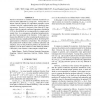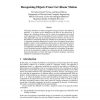100 search results - page 10 / 20 » Structure From Motion Using Sequential Monte Carlo Methods |
CDC
2009
IEEE
14 years 8 days ago
2009
IEEE
— Multi-agent coordination problems can be cast as distributed optimization tasks. Probability Collectives (PCs) are techniques that deal with such problems in discrete and conti...
NIPS
2007
13 years 9 months ago
2007
Rosetta is one of the leading algorithms for protein structure prediction today. It is a Monte Carlo energy minimization method requiring many random restarts to find structures ...
ICASSP
2008
IEEE
14 years 2 months ago
2008
IEEE
Bayesian estimation in nonlinear stochastic dynamical systems has been addressed for a long time. Among other solutions, Particle Filtering (PF) algorithms propagate in time a Mon...
BMVC
2000
13 years 9 months ago
2000
This paper introduces an object recognition strategy based on the following premises: i) an object can be identified on the basis of the optical flow it induces on a stationary ob...
ICASSP
2011
IEEE
12 years 11 months ago
2011
IEEE
The Structural SIMilarity Measure (SSIM) combined with the sequential Monte Carlo approach has been shown [1] to achieve more reliable video object tracking performance, compared ...


